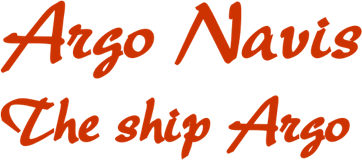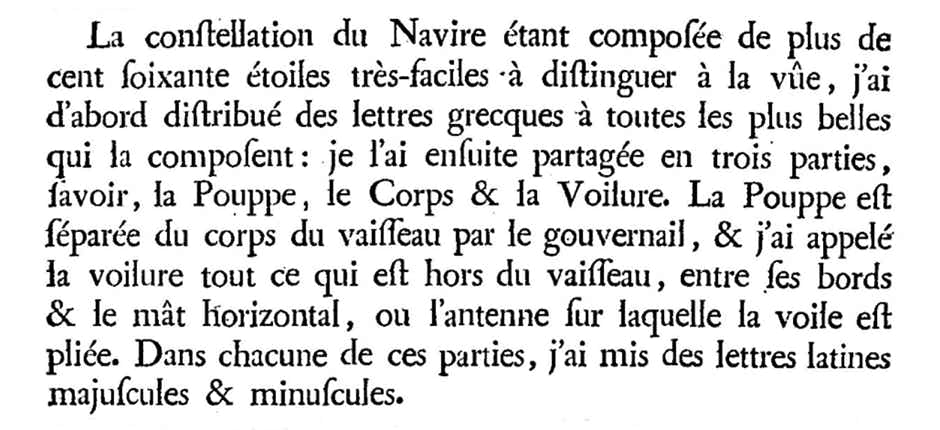
Argo (Ἀργώ in Greek) is a constellation that is not so much disused as dismantled. It was one of the 48 constellations known to Greek astronomers, as listed by Ptolemy in the Almagest, but the 18th-century French astronomer Nicolas Louis de Lacaille found it large and unwieldy and so divided it into three parts: Carina, the Keel or body; Puppis, the Poop (i.e. stern); and Vela, the Sails. Were the three parts to be reunited, the resulting figure would be almost 28% larger in area than the current largest constellation, Hydra.
The modern constellation Pyxis, the compass, invented by Lacaille, occupies an area next to the mast, but it is not considered a part of the original Argo. In 1844 the English astronomer John Herschel proposed replacing Pyxis with a fourth subdivision of Argo which he called Malus, the mast, but this suggestion was not widely adopted.
Voyage of the Argo
Argo Navis represents the 50-oared galley (a penteconter) in which Jason and his crew of Argonauts sailed to fetch the golden fleece from Colchis, on the eastern shores of the Black Sea in present-day Georgia. This fleece, incidentally, came from the ram that is now represented by the constellation Aries.
Jason was the rightful successor to the throne of Iolcus in eastern Greece. But the throne had been seized by his arrogant uncle Pelias while Jason was still a child and there seemed no chance that Jason would inherit it. When Jason had grown into a man, Pelias deceitfully offered to relinquish the throne if Jason could bring back the golden fleece from Colchis. It was a round trip of over 2,000 miles, and Pelias secretly hoped that Jason would perish along the way.
First, he needed a ship capable of such an epic voyage. Jason entrusted its construction to Argus, after whom it was named. Argus built the ship under supervision of the goddess Athene at the port of Pagasae (the modern Volos), using timber from nearby Mount Pelion.
Into the prow Athene fitted an oak beam from the oracle of Zeus at Dodona in north-western Greece. This area, like the island of Corfu nearby, was once noted for its forests of oak, before later shipbuilders stripped them bare. Being part of an oracle, this oak beam could speak and it was crying out for action by the time the Argo left harbour.
Argo Navis dominates this crowded scene in the southern celestial hemisphere from Chart II of the Uranographia of Johann Bode (1801). On the blade of one of the steering oars lies the bright star Canopus (lower right), now part of the constellation Carina.
The prow of the ship was usually imagined as vanishing into the mists of the Milky Way, but here the clouds are replaced by Charles’s Oak (which Bode named Robur Caroli II), a now-obsolete constellation invented by Edmond Halley. As in Lacaille’s earlier depiction, this version of Argo has no main mast rising from the body of the ship. Instead, the spar around which the sail is wrapped appears to emerge from the stern at upper right. Because of Argo’s considerable size, cartographers struggled to depict it successfully on a single chart. For some alternative views see here.
Jason took with him 50 of the greatest Greek heroes, including the twins Castor and Polydeuces, the musician Orpheus, as well as Argus, the ship’s builder. Even Heracles interrupted his labours to join the crew.
Apollonius of Rhodes, who wrote the epic story of the ship’s voyage to Colchis and back, described Argo as the finest ship that ever braved the sea with oars. Even in the roughest of seas the bolts of Argo held her planks together safely, and she ran as sweetly when the crew were pulling at the oars as she did before the wind. Isaac Newton thought the voyage of the Argo was commemorated in the 12 signs of the zodiac, although the connections are hard to see.
Through the Clashing Rocks
Among the greatest dangers the Argonauts faced en route were the Clashing Rocks, or Symplegades, which guarded the entrance to the Black Sea like a pair of sliding doors, crushing ships between them. As the Argonauts rowed along the Bosporus, they could hear the terrifying clash of the Rocks and the thunder of surf. The Argonauts released a dove and watched it fly ahead of them. The Rocks converged on the dove, nipping off its tail feathers, but the bird got through. Then, as the Rocks separated, the Argonauts rowed with all their might. A well-timed push from the divine hand of Athene helped the ship through the Rocks just as they slammed together again, shearing off the mascot from Argo’s stern. Argo had become the first ship to run the gauntlet of the Rocks and survive. Thereafter the Clashing Rocks remained rooted apart.
Once safely into the Black Sea, Jason and the Argonauts headed for Colchis. There they stole the golden fleece from King Aeëtes, and made off with it back to Greece by a roundabout route. After their return, Jason left the Argo beached at Corinth, where he dedicated it to Poseidon, the sea god.
Eratosthenes said that the constellation represents the first ocean-going ship ever built, and the Roman writer Manilius concurred. However, this attribution must be wrong because the first ship was actually built by Danaus, father of the 50 Danaids, again with the help of Athene, and he sailed it with his daughters from Libya to Argos.
Argo in the sky
Only the aft part of Argo is shown in the sky; Ptolemy referred to the ship as being ‘cut off’ ahead of the mast. Map-makers attempted to account for this truncation either by depicting the ship’s prow vanishing into a bank of mist, as Aratus described it, or by passing between the Clashing Rocks, as shown on Bayer’s atlas. Robert Graves recounts the explanation, seemingly due to the Greek playwright Euripides in the 5th century BC, that Jason in his old age returned to Corinth where he sat beneath the rotting hulk of Argo, contemplating past events. Just at that moment the rotten beams of the prow fell off and killed him. Poseidon then placed the rest of the ship among the stars. Hyginus, though, says that Athene placed Argo among the stars from steering oars to sail when the ship was first launched, but says nothing about what happened to the prow. Edmond Halley attempted to solve the problem in 1678 by laying a new constellation, Robur Carolinum, over the missing prow but this invention did not last.
Ptolemy listed 45 component stars of Argo in the Almagest, more than in any other constellation (although Aquarius has the same number if three ‘unformed’ stars are included in the total). He carefully explained where each star lay in the overall figure – for example, ‘the more advanced of the two stars in the stern-ornament’ (the star we know as 11 Puppis) and ‘the star on the cut-off of the deck’ (the present-day Psi Velorum). Surprisingly, there was no mention of any oars other than two steering oars; Ptolemy seemingly imagined Argo as more like a sailing ship than the galley of Greek myth.
Argo appears to travel stern-first as the sky rotates. Aratus likened this to a ship entering port with the oarsmen back-paddling as they approached their moorings.
Three subdivisions
Argo was first split into three parts by the French astronomer Nicolas Louis de Lacaille in his catalogue of the southern stars published in 1756 and it now lies permanently dismembered. In the notes to his catalogue Lacaille wrote: ‘I have divided [Argo] into three parts, namely la Pouppe [Puppis], le Corps [Carina] & la Voilure [Vela]’. On his chart, though, he still showed it as one constellation. Pyxis, the ship’s compass, was also introduced by Lacaille in this same area but he listed it separately, among his 14 new constellations, and so it is not considered a part of Argo, despite occasional assertions to the contrary.
There is, though, still an echo of Argo’s former unity. Lacaille was dissatisfied with Bayer’s allocation of Greek letters to the stars of Argo, so he decided to change them. However, when he did so, he used just one sequence of Greek letters, from Alpha to Omega, as though Argo were still a single figure. The designations Alpha and Beta were given to the two brightest stars of Argo, which are in Carina; hence there are no stars labelled Alpha or Beta in either Puppis or Vela. Equally, the brightest star in Puppis is Zeta and the brightest in Vela is Gamma, but there is no Zeta or Gamma Carinae.
Over the centuries Argo has been subject to a wider range of visualizations by map-makers than any other constellation, from a galley with oars as in the original myth to a three-masted galleon with billowing sails, quite unlike anything known to the ancient Greeks – see the next page for examples.
© Ian Ridpath. All rights reserved
John Herschel’s proposal for replacing Lacaille’s constellation Pixis Nautica with Malus, as published in the Monthly Notices of the Royal Astronomical Society in 1844. His proposal was not adopted, but the name Pixis Nautica was shortened, with a change of spelling, to simply Pyxis.
Lacaille’s description of his division of Argo into three parts: the stern or poop deck (Pouppe), the hull (Corps), and the sails (Voilure). He also allocated a new set of Greek and Roman letters to the stars of the ship in place of Bayer’s originals.





